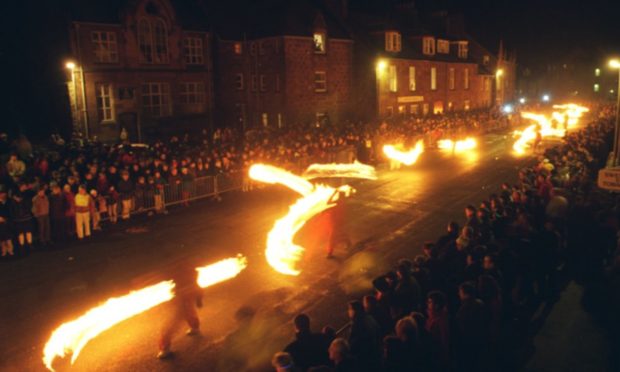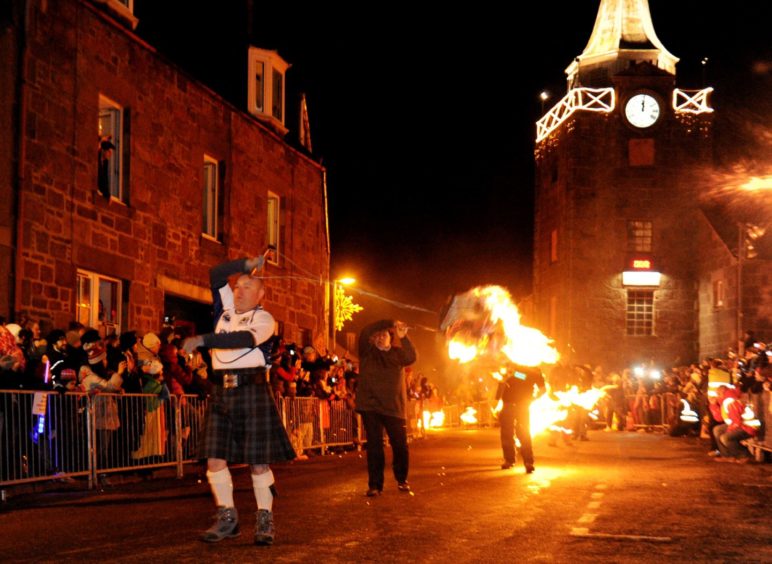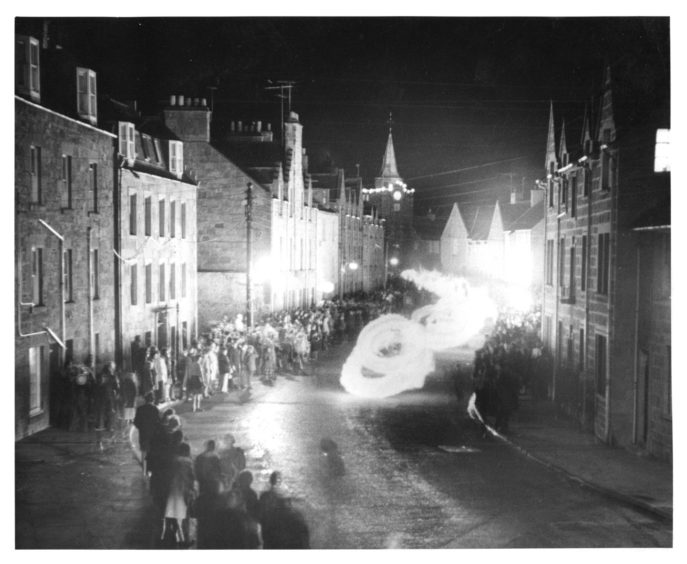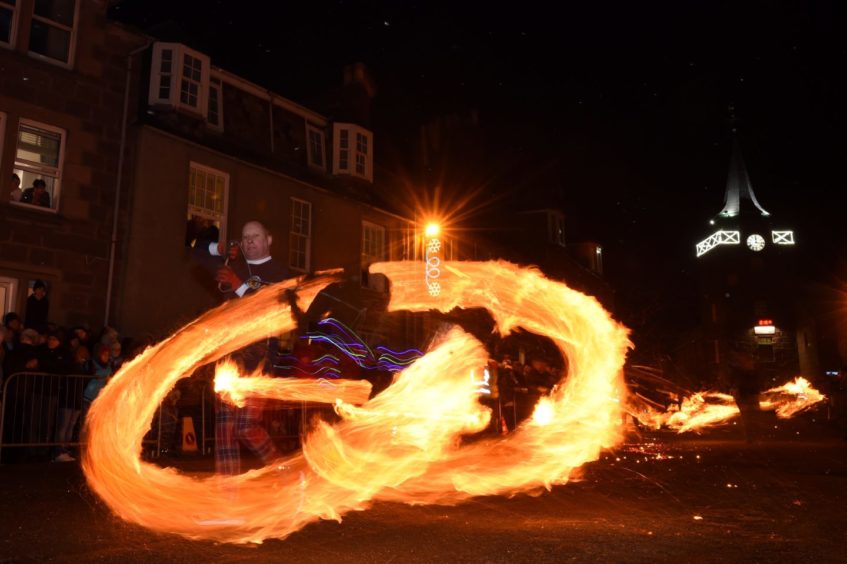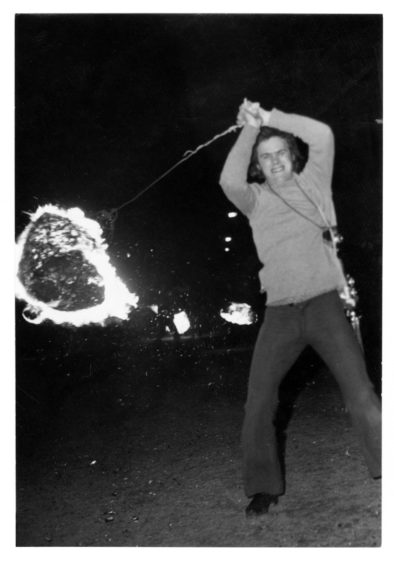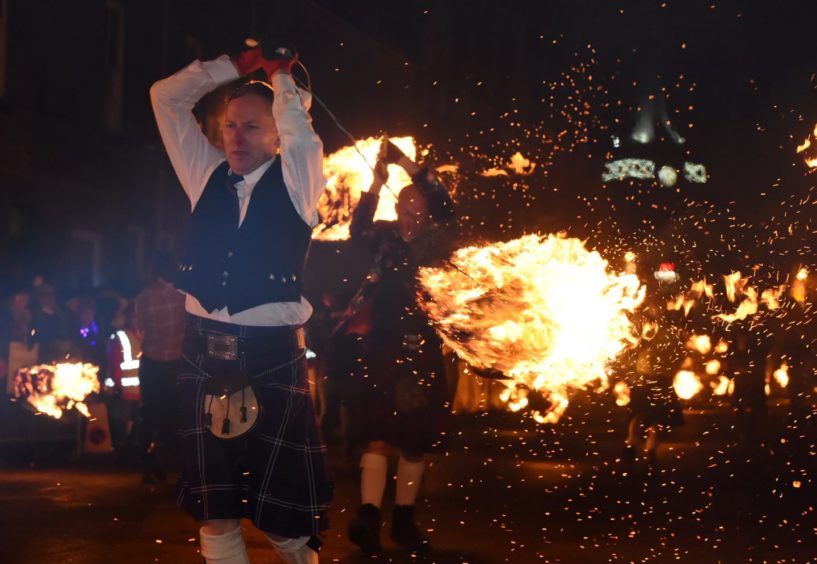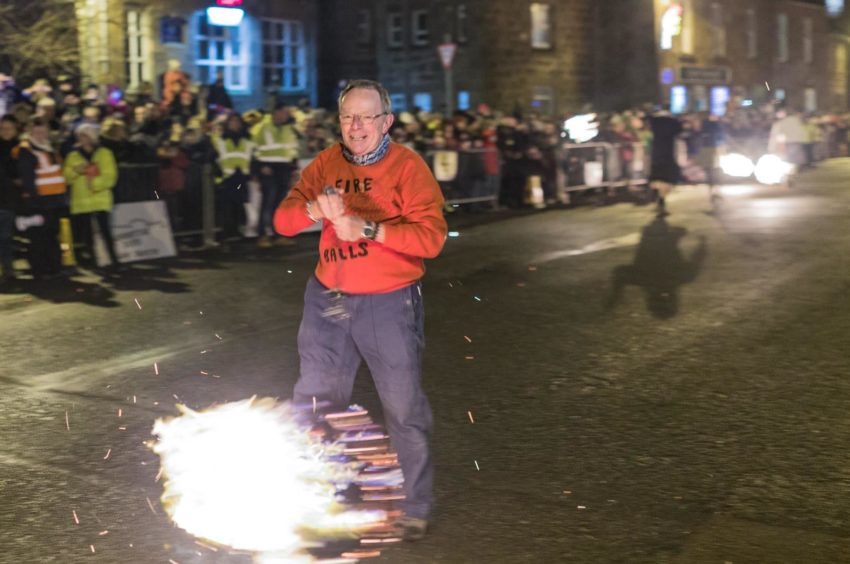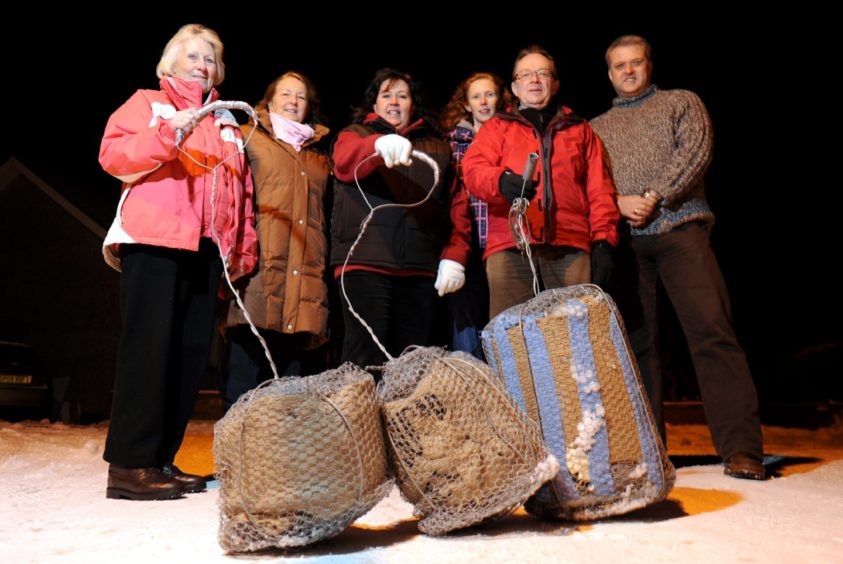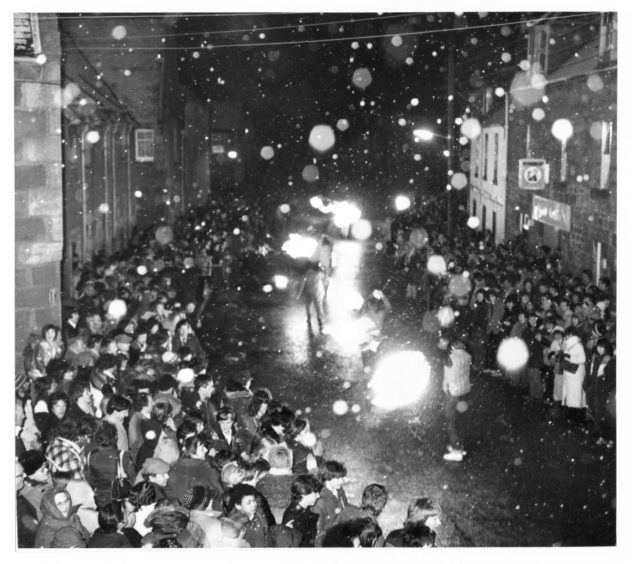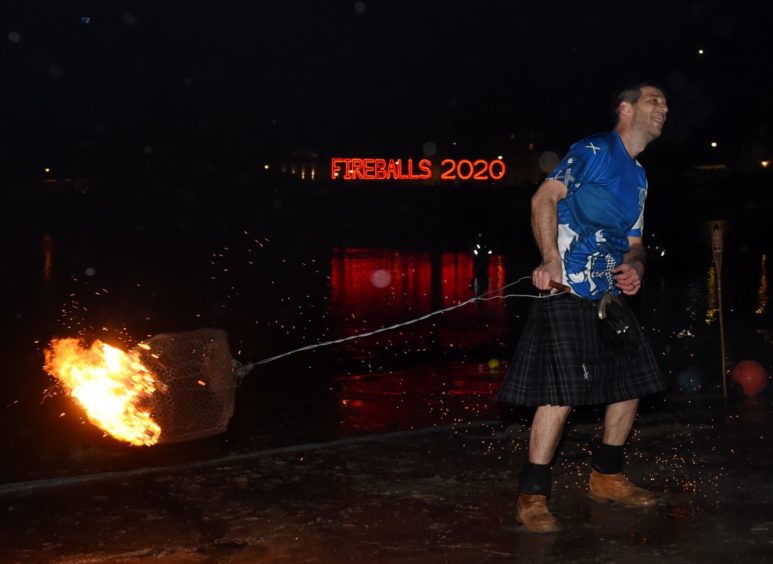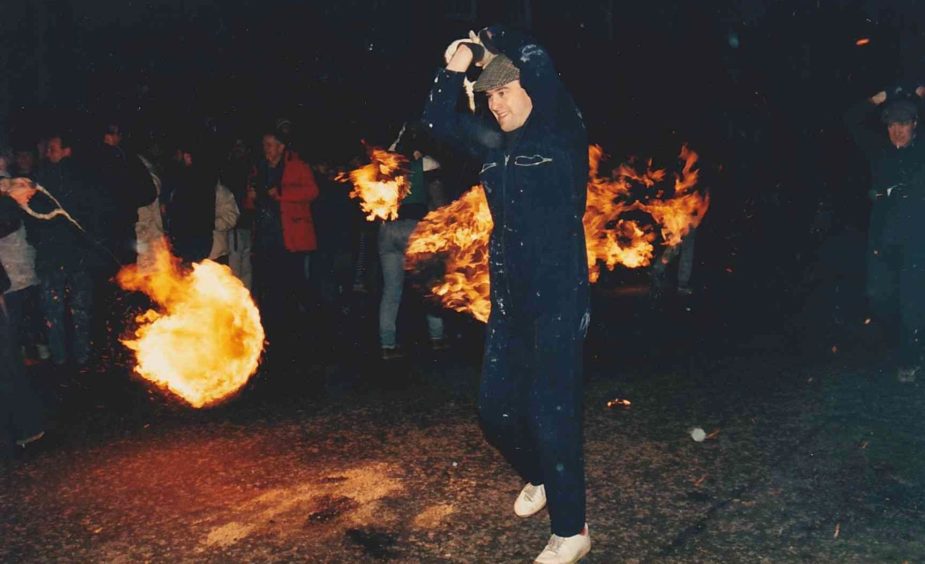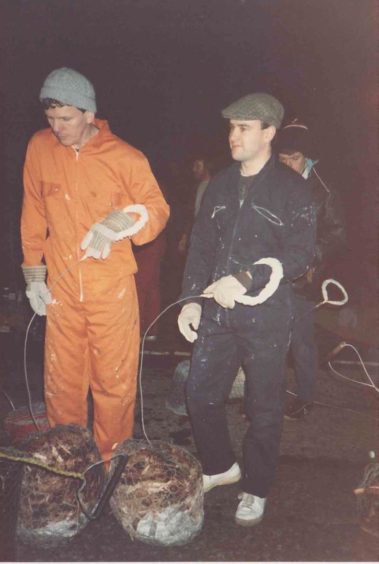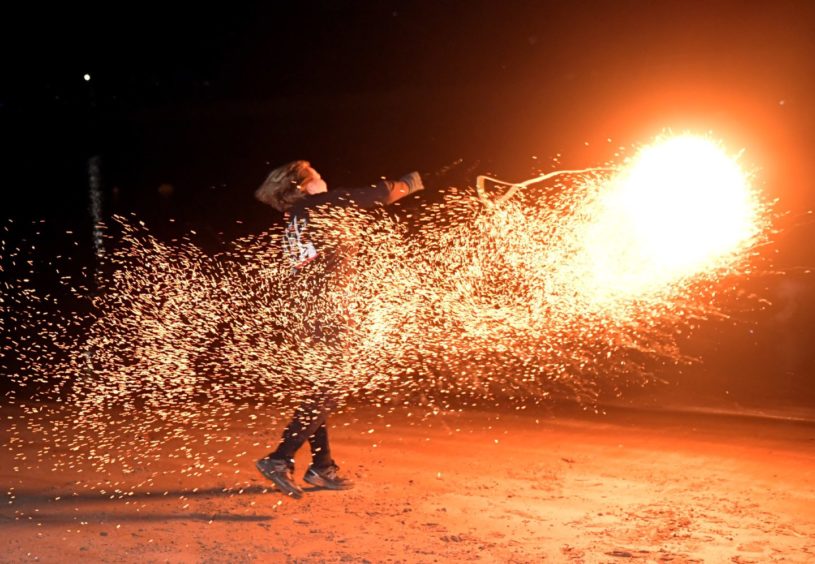Normally, Hogmanay would see Stonehaven’s High Street transformed into a river of flames, resounding to the roar of thousands of spectators cheering on the annual fireball ceremony.
But this is no normal year. At the stroke of midnight, the only sound on the empty streets of the Old Town will be the chiming of the clock, the only cheerful light coming from still twinkling Christmas decorations.
Coronavirus means that, other than halting during the war years, Stonehaven’s fireball ceremony has been cancelled for the first time in its history.
And it is a history whose origins have been “lost in the mists of time,” said Martin Sim, founding chairman of the Stonehaven Fireballs Association and the organisations archivist.
Fiery parade of swingers
But the Hogmanay event, which usually attracts some 10,000 people to the High Street to watch the spectacular, fiery parade of swingers seeing out the old year and bringing in the new, doesn’t stretch quite as far back as you might imagine.
“It’s sad in a way, but we have no idea why or exactly when it started,” said Martin, adding any records kept had been lost at the time he helped set up the association in 2002.
“The first mention of it in the press is in 1908. The entry in the paper of the day just states the fireballs took place, as though everybody knew what was happening. We can only presume they were already established and didn’t need explained what the fireballs were because people already knew.”
He added a previous member of the association told of his wife’s grandfather recalling seeing the fireballs in the 1870s.
Not back to the Stone Age
Martin, who swung his first fireball in 1978, doubts any speculation the ceremony descended from some form of ancient pagan ritual.
“For what we do, you need to have wire and wire has to be manufactured, so it’s not going back to the Stone Age,” he said.
As to why it came to be, Martin believes Stonehaven’s role as a fishing community and seaport may have had a part to play as local people became aware of older fire ceremonies taking place around the world.
“It is quite possible people could have visited Stonehaven, or people from Stonehaven could have visited other parts of the world, and brought this ceremony back with them, having seen it and thought ‘hey, that’s a good excuse for a fun evening’.”
No matter where or how it started, the fireballs of the early days were different to the ones that are today known around the world – and were even beamed across the globe to see in the new millennium.
It would have been a tradition for the people of the old town itself – both men and women – but one you took part in, not just stood around and watched.
Built to burn for hours
“It certainly seems the ceremony was part of Hogmanay,” said Martin. “Visiting neighbours, friends and family was what Hogmanay was about. So the guys would light the fireballs, starting from the front of the clock and they would walk a short distance and stop outside the house of family and friends and go in for a dram.
“They would come out after a while, pick up their fireball and swing it another two or three turns, and go into another house. It was much more sociable. People didn’t stand and watch the fireballs, because they were just going on all the time,” adding early fireballs would have been built to burn for hours.
That stands in sharp contrast to today’s ceremony, which starts as the bells chime midnight, with the swingers parading from the clock tower up to Cannon Court and back until the last fireball is thrown into the harbour at 25 minutes past midnight.
The old community-based tradition of the fireballs dwindled as people of the old town were moved out of sub-standard housing to more modern homes in Stonehaven. As this was happening, so too the fishing industry was petering out, with its focus on activities around the harbour.
It meant some lean years for the fireballs with some Hogmanay dates seeing as few as 10 or 12 swingers, leaving it in danger of “dying a death”, said Martin.
Magic of doing it
However, in the 1970s, local people once again came to the rescue, re-igniting interest in the fireballs – led principally by the Emslie family – Jack, Bill and George. The Emslie family cleared away the myth it was an exclusive club and appealed for people to join in.
During the 1990s, however, more hurdles arose for the fireballs, with some years seeing urgent appeals for help to keep the spark alight. In 2002, Martin was one of a group of fireball swingers who felt things weren’t as good as they could be and decided to tackle the issues head on by setting up the Stonehaven Fireballs Association.
One of those changes included looking at what goes into a fireball – which swingers for the most part make themselves as part of “the magic of doing it”.
Martin said: “When I started it was really basically anything flammable. That was okay up to a point until you walked behind someone who had diesel fuel in theirs. Once you have walked behind a diesel-fuelled fireball you realise some things should not be put in a fireball.
United Nations of happy revellers
“As you were swinging your fireball you were kicking stuff out of the way, left right and centre – burning embers, coal and wood. The hazard associated with that was obvious and needed to be seen to.
“So as part of the reorganisation we did after 2002, was one saying only natural combustible material, no artificial accelerants or propellants, no plastic, no rubber. In the past people have spoken about being part of the crowd where they were splashed by material that had melted or was part of the fuel for the fireball.
“So now we initially fire things up with paraffin, but just a small amount which is only there as a starter.”
The fireballs have gone from strength-to-strength and now attract thousands of people from across the globe, feeling part of something special, part of the community of Stonehaven as it welcomes in a new year. On a normal Hogmanay, the High Street becomes a United Nations of happy revellers, with accents and languages from across the world. It is a major tourism draw for Stonehaven and the north-east.
But that isn’t the point of the fireballs, said Martin.
Do it for ourselves
“We have always said we don’t do it to be watched, we do it for ourselves. It is just part of your being that you swing a fireball at Hogmanay, even if no one was watching.
“It’s the fireballs that are the important thing. It is the noise that they make, it’s the smell they make, it’s the sight that they are. It is the fireballs.
“Spectators definitely add something to it. The cheering and the shouting and the roars from the crowd, add a tremendous amount to the ceremony. But the ceremony exists in an entirety in itself, it does not need the spectators.”
And this year there won’t be any spectators. There won’t be any fireballs. Full stop.
“This year, despite a lot of background work, even after officially the event was cancelled we were still trying to see if some sort of tentative token participation could happen,” said Martin. “But it is just not worth it. The way the precautions and recommendations from the Scottish Government have been it is best that we don’t even try.”
That is real sadness for Martin and for everyone involved in this much-loved, traditional spectacle.
“Since I started I have swung a fireball every year. I have always been here and able to do it. It is sad not to do it. I thought I could always light a fireball and swing it in my garden, but it’s not going to be the same. It is not the fireballs, it is not in the Old Town, so why bother?”
But there is little doubt the fireballs will return next year – Covid permitting – to burn as brightly as every.
Goodness gracious great balls of fire
While being one of those who have helped set the night ablaze to bring in Stonehaven’s New Year is an honour, it isn’t easy…
I know, because I’ve done it.
My stint as a swinger came in the early 80s (I can’t quite pin the year. That, like the origins of the fireballs, is lost in the mists of time).
My then partner came from Stonehaven and I’d seen the fireballs a few times and they had fairly impressed this callow youth from Edinburgh at a time when the capital celebrated Hogmanay by doing diddly-squat.
Tarmac bubbling at feet
I loved the pagan feel of the fireballs – faux or real – and the first footing that went on for relentless hours afterwards. So when I was offered a shot, I jumped at the chance.
A family friend made my fireball for me, so the first time I clapped eyes on it was as the clock ticked to midnight. Clutching the wire handle in the tight confines of Keith Place, wearing a boiler suit and a bunnet, I was wondering if there was a pecking order or how we would move off.
That’s when I heard a sloshing noise and felt my feet getting wet. The guy next to me was pouring paraffin all over my fireball and my shoes. Next thing I knew the clock was chiming, someone touched their lit fireball to mine and the thing went “whumph” as it burst into flames.
When I noticed the tarmac was bubbling under the flames as the temperature around me soared, I thought “I’m out of here” and off I went, pecking order be damned.
Which was when I realised I had bitten off more than I could chew. I was trying to swing a burning, heavy bundle around my head while walking up a High Street crammed with folk and not a crash barrier in sight. Ah, the 80s when health and safety was a “what’s that then”.
Viking funeral for dignity
The motion of the fireball kept me off balance the whole time, I was terrified that someone was going to dart out of the crowd and get smacked on the head by my flammable concoction of God knows what as I hadn’t built it. All this while trying to dodge other swingers. I was exhausted after barely 20 yards.
The idea was to walk up to the cannon embedded on the High Street then back to the harbour slipway and repeat and repeat and repeat until you were left holding some embers in rabbit wire that you tossed in the harbour.
I have no shame in admitting I made that trip once before jettisoning a still blazing fireball into the harbour water like some sort of Viking funeral homage to my dignity.
Still, I did it and now my name has been added to the roster of fireball swingers by archivist Martin Sim. I’m proud of that.
